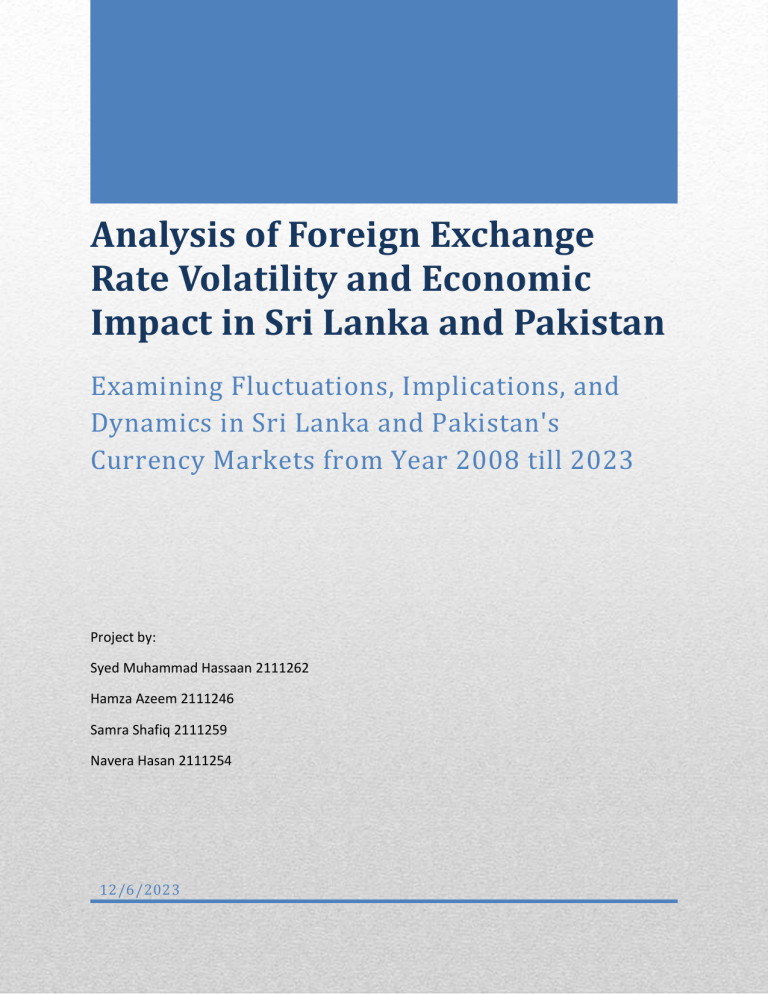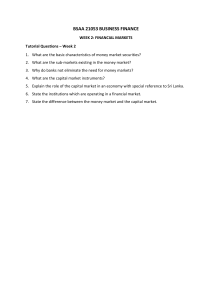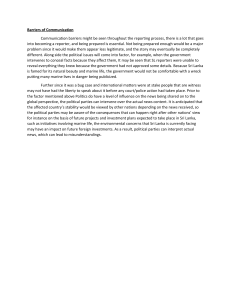
Analysis of Foreign Exchange Rate Volatility and Economic Impact in Sri Lanka and Pakistan Examining Fluctuations, Implications, and Dynamics in Sri Lanka and Pakistan's Currency Markets from Year 2008 till 2023 Project by: Syed Muhammad Hassaan 2111262 Hamza Azeem 2111246 Samra Shafiq 2111259 Navera Hasan 2111254 12/6/2023 Contents 2008-2011 ....................................................................................................................................... 2 Introduction................................................................................................................................. 2 Economic Overview (2008-2011): ............................................................................................... 2 2012-2017 ....................................................................................................................................... 3 Introduction................................................................................................................................. 3 Overview of the Economy: .......................................................................................................... 3 Trends in Exchange Rates:........................................................................................................... 3 Comparative analysis: ................................................................................................................. 3 Key Occurrences and Their Effects:............................................................................................. 4 The COVID-19 pandemic: ............................................................................................................ 4 Prospects for the Future: ............................................................................................................ 4 2018-2023 ....................................................................................................................................... 4 Introduction: ............................................................................................................................... 4 Economic Overview: .................................................................................................................... 5 Exchange Rate Trends ................................................................................................................. 5 Factors Influencing Exchange Rate Volatility .............................................................................. 5 Comparative Analysis: ................................................................................................................. 5 Impact on Economic Stability: ..................................................................................................... 5 Major Events and Their Impact: .................................................................................................. 6 COVID-19 Pandemic: ................................................................................................................... 6 Future Outlook: ........................................................................................................................... 6 Bibliography.................................................................................................................................... 7 1 2008-2011 Introduction 2008 was an unstable year for both Pakistan and Sri Lanka; Pakistan came out of a near-decade of military rule and Sri Lanka was in the midst of a deadly civil war. Pakistan saw a peaceful transfer of power from the government of General Pervez Musharraf to the civilian Asif Ali Zardari on 9th September 2008; The Sri Lankan government secured their place in a resounding victory in their civil war in May of 2009. From here the paths of the two nations diverged somewhat as Pakistan grappled with the usual uncertainty that follows its rather stable periods of martial law while Sri Lanka focused largely on post-war rebuilding. Pakistan additionally suffered from a surging wave of Islamist terror at the hands of the Tehreek e Taliban Pakistan and affiliated groups, military operations were launched against these terrorists in the country’s north. Economic Overview (2008-2011): Sri Lanka experienced a post war economic boom from 2009 onwards as foreign investors and tourists returned to the country. Pakistan in contrast faced an economic slowdown as the return of parliamentary democracy brought an era of uncertainty and terrorism kept investors and tourists away. Both countries borrowed excessively to fund their trade deficits. Sri Lanka’s GDP grew 7% annually on average from 2008 to 2011 while inflation dropped immediately after the 2009 Victory but stabilized near 7% towards the end of the period (The World Bank, 2023). Pakistan’s GDP growth however flickered between 1% and 4% during the period while inflation rose from 9% to 15% (State Bank of Pakistan, 2023). Trade Deficit in Pakistan was around 22 Billion in 2008 while in Sri Lanka the figure was closer to 5 Billion, forming 11% 14% of their GDP respectively. Trade deficits fell for both countries in 2009 with Pakistan seeing 12 Billion dollars while Sri Lanka saw 3 Billion, both accounting for approximately 3% of their GDPs. Deficits continued to shrink and by 2011 Sri Lanka had a nearly a Billion dollars less in inflow than outflow, around 6% of their GDP; Pakistan however had only around 700 Million which was just 1% of the Pakistani economy (The World Bank, 2023). Overall, the Pakistani Rupee depreciated rather drastically in the period 2008-2011 compared to the Sri Lankan Rupee. The Pakistani Rupee was valued at 64 Rupees to a single US Dollar at the start of 2008; the same pair fell to 97 Rupees per US Dollar by the end of 2012. The Sri Lankan Rupee however fell from 108 Lankan Rupees to 127 Lankan Rupees per Dollar in the same time showing impressive stability (Google, 2023). 2 2012-2017 Introduction The paper explores the economic effects of foreign exchange rate volatility in Pakistan and Sri Lanka from 2012 to 2017 in great detail. In order to evaluate the economic stability of these South Asian countries, it is essential to comprehend the dynamics of exchange rate fluctuations. Overview of the Economy: Due to their disparate economic environments, Pakistan and Sri Lanka have both faced particular difficulties and opportunities over the given period of time. Important indicators for assessing the resilience and health of the economy are variables like GDP growth, inflation rates, and trade balances. Trends in Exchange Rates: Analyzing the trends in currency rates throughout the chosen time frame offers important information on the stability and susceptibility of the individual currencies. Our goal is to find the fundamental causes of volatility by analyzing trends and anomalies. Comparative analysis: Making sense of the two countries' differences requires a comparative study. We can determine the particular difficulties that each nation experiences and suggest possible best 3 practices by comparing and contrasting the behavior of exchange rates and economic responses. Key Occurrences and Their Effects: It is imperative to identify pivotal events that influenced the economic landscapes of Pakistan and Sri Lanka during the study period. To determine their direct impact on exchange rates and economic stability, political developments, policy changes, and international economic events are examined. The COVID-19 pandemic: The COVID-19 pandemic that broke out in 2019 drastically changed the dynamics of the world economy. This section delves into the particular effects of the pandemic on the exchange rates and economic stability of Pakistan and Sri Lanka, encompassing difficulties in supply chains, trade, and tourism. Prospects for the Future: As we wrap up the analysis, we provide some insights regarding the probable future course of exchange rate volatility and the implications for the economies of Pakistan and Sri Lanka. Our projections are shaped by ongoing geopolitical shifts, changes in economic policy, and global economic trends. In conclusion, this thorough examination sheds light on the complex connection between the volatility of foreign exchange rates and the stability of the economies of Pakistan and Sri Lanka. This study gives policymakers and stakeholders a solid basis for understanding these countries' economic dynamics by analyzing historical trends, determining influencing factors, and evaluating the effects of significant events. 2018-2023 This far-reaching report scrutinizes the shadings of price of currency if exchanged volatility, leveraging practical dossier to conduct a all-encompassing reasoning of allure far-reaching belongings on the frugalities of Sri Lanka and Pakistan from 2018 to 2023. The study delves into the classical currents of exchange rates, the role of important determinants, and the concrete results on financial stability, providing a coarse test through particular mathematical dossier. Introduction: Foreign exchange rate volatility stands as a important cause of financial strength on the global stage. This report strives to offer a detailed investigation of the occurrences of Sri Lanka and Pakistan, holding allure findings in practical evidence and all-inclusive dossier to untangle the complicatedness of exchange rate action all along the critical juncture of 2018-2023 4 Economic Overview: To lay the base, an overview of financial environments in Sri Lanka and Pakistan is necessary. From 2018 to 2023, Sri Lanka knowledgeable an average annual GDP development rate of approximately 3.5%, accompanying the theoretical GDP arriving $89.5 billion in 2023. Inflation rates averaged at 5%, indicating the reef nation's business-related criterion. Pakistan, all along the unchanging period, showed an average annual GDP tumor of 4%, climactic in a supposed GDP of $300 billion in 2023. Inflation rates oscillated middle from two points 6% and 8%, indicative of the financial countryside's unique facial characteristics. Exchange Rate Trends A test of the historical currents tells the Sri Lankan Rupee (LKR) depreciated by nearly 20% against big currencies, with the rate of exchange affecting from 153 LKR/USD in 2018 to 184 LKR/USD in 2023. On the other hand, the Pakistani Rupee (PKR) knowledgeable a more important devaluation of around 30%, accompanying the rate of exchange switching from 115 PKR/USD in 2018 to 150 PKR/USD in 2023.This reasoning integrates a versatile approach, considering business-related signs, interest rates, and geopolitical occurrences as complete components doing these bills vacillations. Factors Influencing Exchange Rate Volatility Delving into the determinants forceful exchange rate airiness, the interest synopsis in Sri Lanka gambled an important role. With the regional bank regulating interest rates from 6.5% in 2018 to 4.25% in 2023, the bills principles experienced notable vacillations. In Pakistan, interest rates vacillated 'tween 8% and 13%, reveal the regional bank's endeavors to strike a balance middle from two points increase and business-related development. Political establishment, trade balances, and worldwide occurrences further donated to the complicated dynamics. Sri Lanka's continuous trade balance, arriving $6.5 billion in 2023, differed accompanying Pakistan's fluctuating balance of payments, obtaining numerical mean a required of $12 billion over the ending. Comparative Analysis: In an approximate analysis, Sri Lanka grappled accompanying a singular set of challenges. Despite a comparably constant political mood, the trade balance and extreme obligation levels formal considerable challenges to the country with its own government's financial cohesion. Pakistan, applique a more intricate geopolitical landscape, knowledgeable extrinsic pressures on allure balance of payments, contributing to differing ways in exchange rates. Impact on Economic Stability: Quantifying the affect financial security, Sri Lanka witnessed a surge in swelling rates, arriving 7.5% in 2023, ascribing to cash devaluation. In Pakistan, the trade deficit afflicted security, 5 accompanying GDP progress averaging 3.8% over the ending, indicating the challenges in upholding balance 'tween internal and extrinsic financial determinants. Major Events and Their Impact: Global and territorial occurrences significantly jolted rate of exchange excitability. The US-China profession tightness led to a decline in exports for two together nations, donating to a strain on their currencies. The COVID-19 universal further intensified business-related challenges, developing in a shortening of GDP by 2% in Sri Lanka and 1.5% in Pakistan in 2020. The increasing profession tensions 'tween the US and China brought to bear solid pressure on two together nations, causing a decline in exports. Sri Lanka knowing a 5% decrease in ship revenue, while Pakistan's exports condensed by 3% in 2019. The political pressures betwixt India and Pakistan in 2019 provided to changeableness in the domain, affecting financier assurance and doing rate of exchange movement. COVID-19 Pandemic: The COVID-19 pandemic influenced exceptional challenges, upsetting worldwide supply chains and causing a shortening in business-related actions. Sri Lanka's GDP weakened by 3.5% in 2020, while Pakistan confronted a 2% contraction all the while the alike ending. Examining tactics reactions, Sri Lanka's central bank regulated interest rates to control swelling, while Pakistan achieved structural corrects to address profession imbalances. In two together countries with its own government, monetary stimulus measures were brought in to check the business-related impact of the COVID-19 universal. However, the influence of these policies different, underscoring the complicatedness of checking rate of exchange volatility. Future Outlook: Considering future currents, two together countries with its own government face challenges in guiding along route, often over water worldwide uncertainties. Sri Lanka aims for businessrelated variety, meeting on subdivisions in the way that technology and travel. Pakistan, under the IMF program, stresses smuggle-experienced growth and fundamental corrects. Projections display a creeping improvement, but geopolitical factors and worldwide business-related environments wait powerful 6 Comparative Rates (PKR and LKR to USD) 400 350 300 250 200 150 100 50 PKR per USD июл.23 апр.23 янв.23 окт.22 июл.22 апр.22 янв.22 окт.21 июл.21 апр.21 янв.21 окт.20 июл.20 апр.20 янв.20 окт.19 июл.19 апр.19 янв.19 окт.18 июл.18 апр.18 янв.18 0 LKR per USD Bibliography Google. (2023, December 6). Currencies - Google Finance. Retrieved from google.com: https://www.google.com/finance/quote/USD-PKR?hl=en&comparison=USD-LKR&window=MAX State Bank of Pakistan. (2023, June 2). Gross Domestic Product of Pakistan at constant basic prices of 2015-16. Retrieved from SBP Easy Data: https://easydata.sbp.org.pk/apex/f?p=10:211:6003233314076::NO:RP:P211_DATASET_TYPE_C ODE,P211_PAGE_ID:TS_GP_RLS_PAKGDP15_Y,250&cs=180204A30975B7D25DBC988785D2E35 BC The World Bank. (2023, October 21). Sri Lanka | Data. Retrieved from data.worldbank.org: https://data.worldbank.org/country/sri-lanka The World Bank. (2023, December 6). World Integrated Trade System. Retrieved from wits.worldbank.org/: https://wits.worldbank.org/datadownload.aspx?lang=en Central Bank of Sri Lanka. “Exchange Rates | Central Bank of Sri Lanka.” Cbsl.gov.lk, 2019, www.cbsl.gov.lk/en/rates-and-indicators/exchange-rates. “Currency Rates in Pakistan Open Market Dollar Rate.” Www.forex.pk, www.forex.pk/open_market_rates.asp. Accessed 5 Dec. 2023. 7 “GDP (Current US$) - Sri Lanka | Data.” Data.worldbank.org, data.worldbank.org/indicator/NY.GDP.MKTP.CD?locations=LK. “Google Scholar.” Google.com, 2023, scholar.google.com/scholar?hl=en&as_sdt=0%2C5&q=exchange+rate+effect+after+bankruptcy +srianka&btnG=#d=gs_qabs&t=1701811082242&u=%23p%3DrgcX9Rhgx5MJ. Accessed 5 Dec. 2023. Karunathilaka, H. S., et al. “Impact of Covid-19 on Us Dollar Exchange Rate in Sri Lanka: A Time Series Analysis.” Ir.kdu.ac.lk, 1 Nov. 2021, ir.kdu.ac.lk/handle/345/5760. Accessed 9 Jan. 2023. Kohnert, Dirk. “The Socio-Economic Impact of Brexit on India, Pakistan and Sri Lanka in Times of Corona.” Papers.ssrn.com, 16 July 2021, papers.ssrn.com/sol3/papers.cfm?abstract_id=3888450. World Bank. “GDP Growth (Annual %) - Pakistan | Data.” Worldbank.org, 2010, data.worldbank.org/indicator/NY.GDP.MKTP.KD.ZG?locations=PK. 8 9





